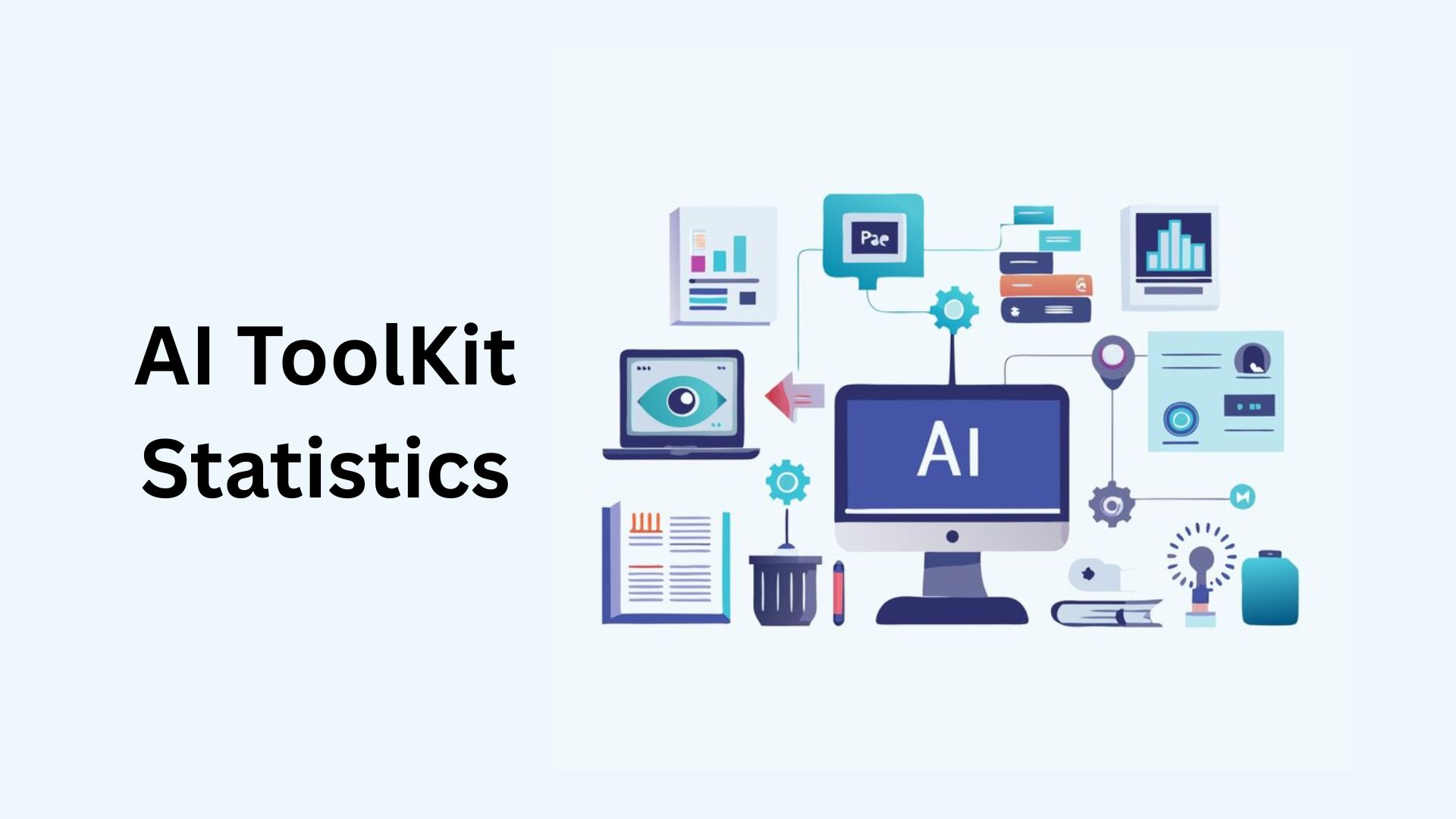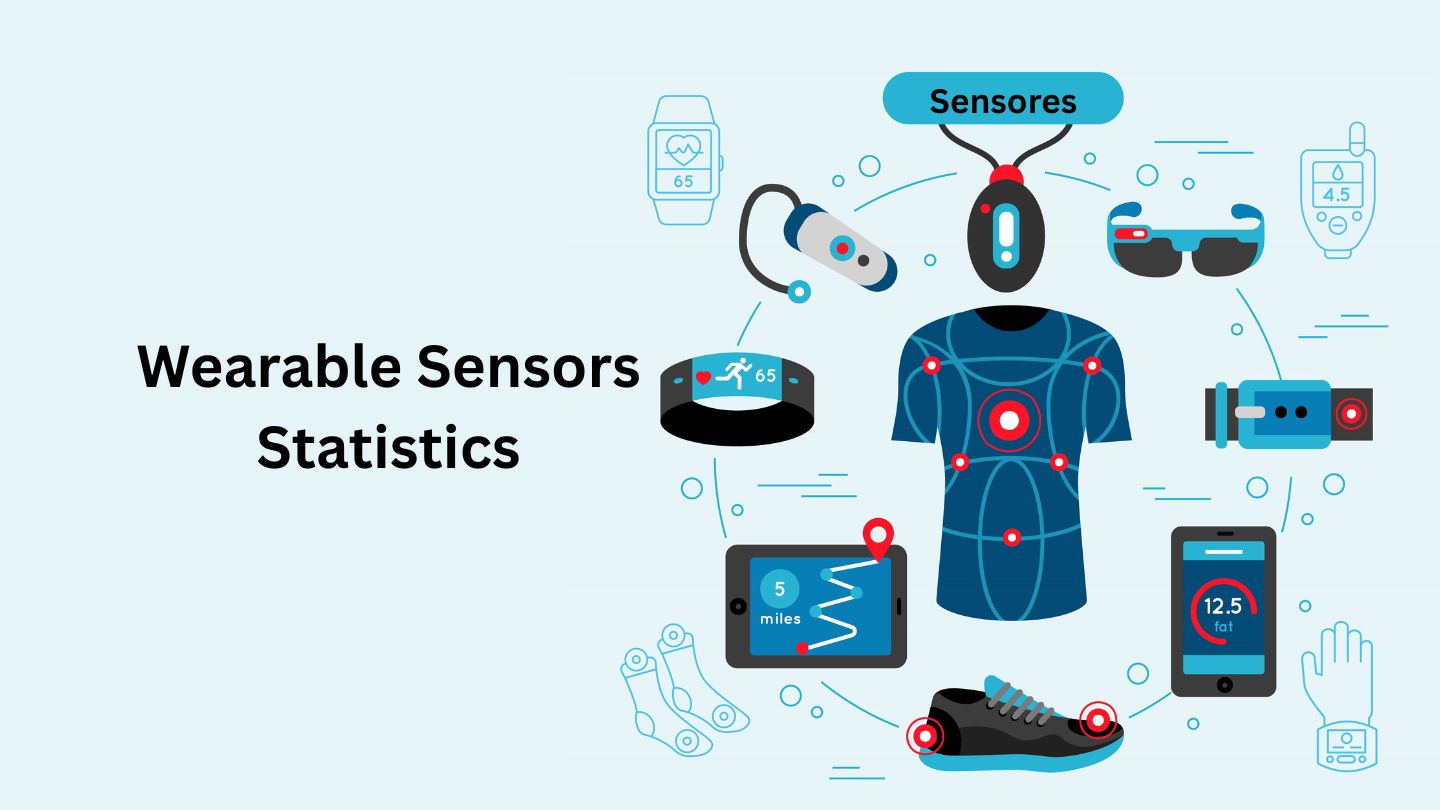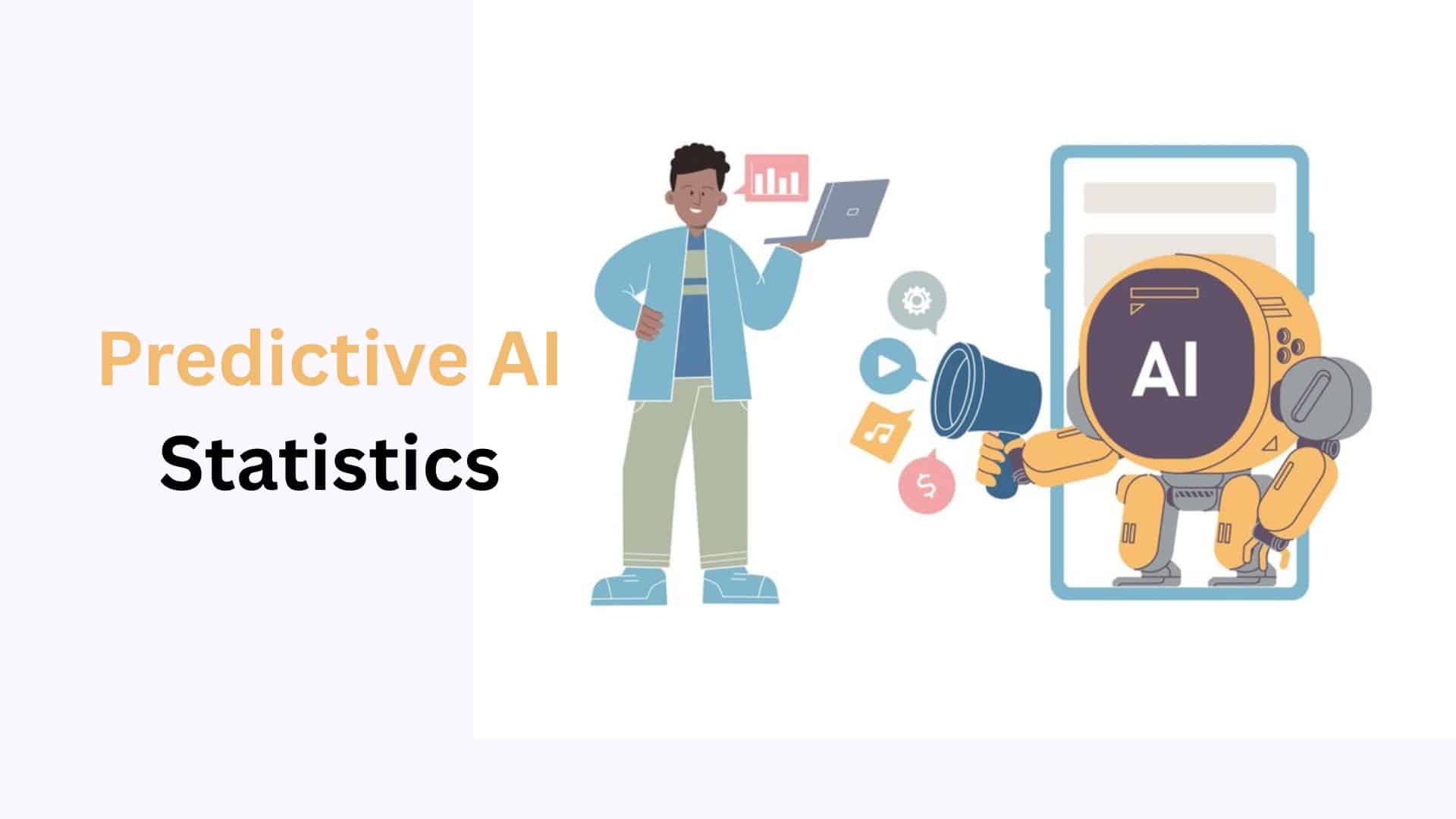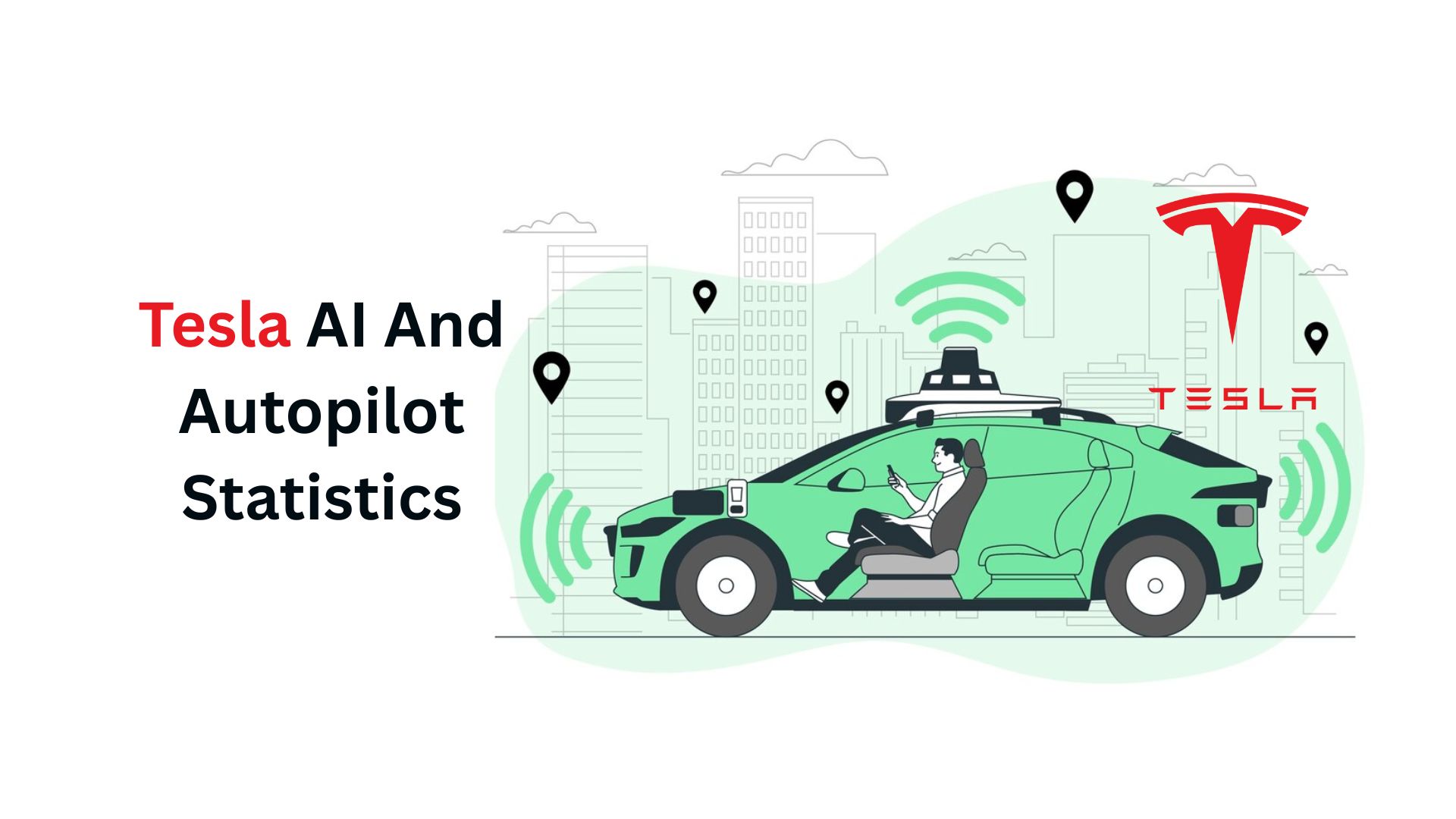Machine Learning Statistics By Market, Revenue, Region, Industry, Platforms, Usage, Business And Future Aspects

Updated · Mar 06, 2025


TABLE OF CONTENTS
- Introduction
- Editor’s Choice
- General Machine Learning Statistics
- Machine Learning Market Statistics
- Machine Learning Revenue Statistics by Country
- By Region
- Machine Learning Statistics by Industry
- By Company’s Usage
- Machine Learning Investment Statistics by Platforms
- Machine Learning Usage Statistics
- Machine Learning Companies Adoption Statistics
- Time Required To Deploy A Single Machine Learning Model
- Machine Learning Usage Statistics
- Machine Learning Statistics in Marketing
- In Business
- AI/ML Impact on Business Supply Chains Statistics by Region
- Impact of AI and ML Use on Retail Performance Statistics
- Demand Influencing Factors of Machine Learning
- Future Aspects of Machine Learning Statistics
- Conclusion
Introduction
Machine Learning Statistics: Machine learning and statistics are connected because both help us understand data and make predictions. Statistics focus on studying data, spotting patterns, and making smart choices. Machine learning, however, uses special methods to learn from data and improve on its own.
These fields are useful in many areas, like healthcare, banking, and technology, to solve tough problems. Statistics depend on math models, while machine learning teaches computers using data. They both help make decisions, predict trends, and automate work. As technology advances, the need for these skills is growing, making them important for data science and AI development.
Editor’s Choice
- Machine Learning Statistics state that the global Machine Learning market will reach USD 79.29 billion in size by 2024.
- As of 2024, about 48% of businesses worldwide have integrated machine learning into their operations.
- Meanwhile, around 80% of companies report that investing in machine learning has led to increased revenue.
- The manufacturing sector holds the largest share of the machine learning market at 18.88%, followed by the finance industry at 15.42%.
- The United States is anticipated to be the industry’s largest market, with a market size of USD 21.14 billion in 2024.
- OpenAI is the most funded machine learning platform, with over USD 11 billion in investments received.
- About 57% of businesses use machine learning to make customer service better.
- On the other hand, around 34% of companies in the U.S. already use machine learning, while 42% are still investigating how to use it.
- The global AI market was worth USD 538.13 billion in 2023, and experts believe it will grow to USD 2,575.16 billion by 2032.
- Similarly, the Natural Language Processing (NLP) market is expected to rise from USD 29.71 billion in 2024 to USD 158.04 billion by 2032.
General Machine Learning Statistics
- The manufacturing industry makes up about 18.88% of the global machine learning market, leading all sectors.
- About 46% of businesses say they use machine learning to detect fraud.
- In addition, only 22% of companies use machine learning to help lower customer churn rates.
- 73% of people choose chatbots over humans for simple question-and-answer help.
- The industry is expected to grow to over USD 500 billion by the end of 2030, a 551% increase from 2024 and 1,005% higher than its value in 2020.
- Machine Learning Statistics: Based on the application, the data processing segment accounted for the highest share, with around 39.2% by 2024.
- Besides, in offering the solution, segments account for a share of 54.2%.
- For instance, by vertical insights, the BFSI segment contributes the highest share, 38.3%.
- Marketing and sales are the most profitable uses of machine learning.
- Machine learning can improve customer satisfaction by about 10%.
- Companies use machine learning mainly to save money and reduce costs, which accounts for 38% of the market.
- Nissan improved their conversion rates by 67% using a machine-learning model.
Machine Learning Market Statistics
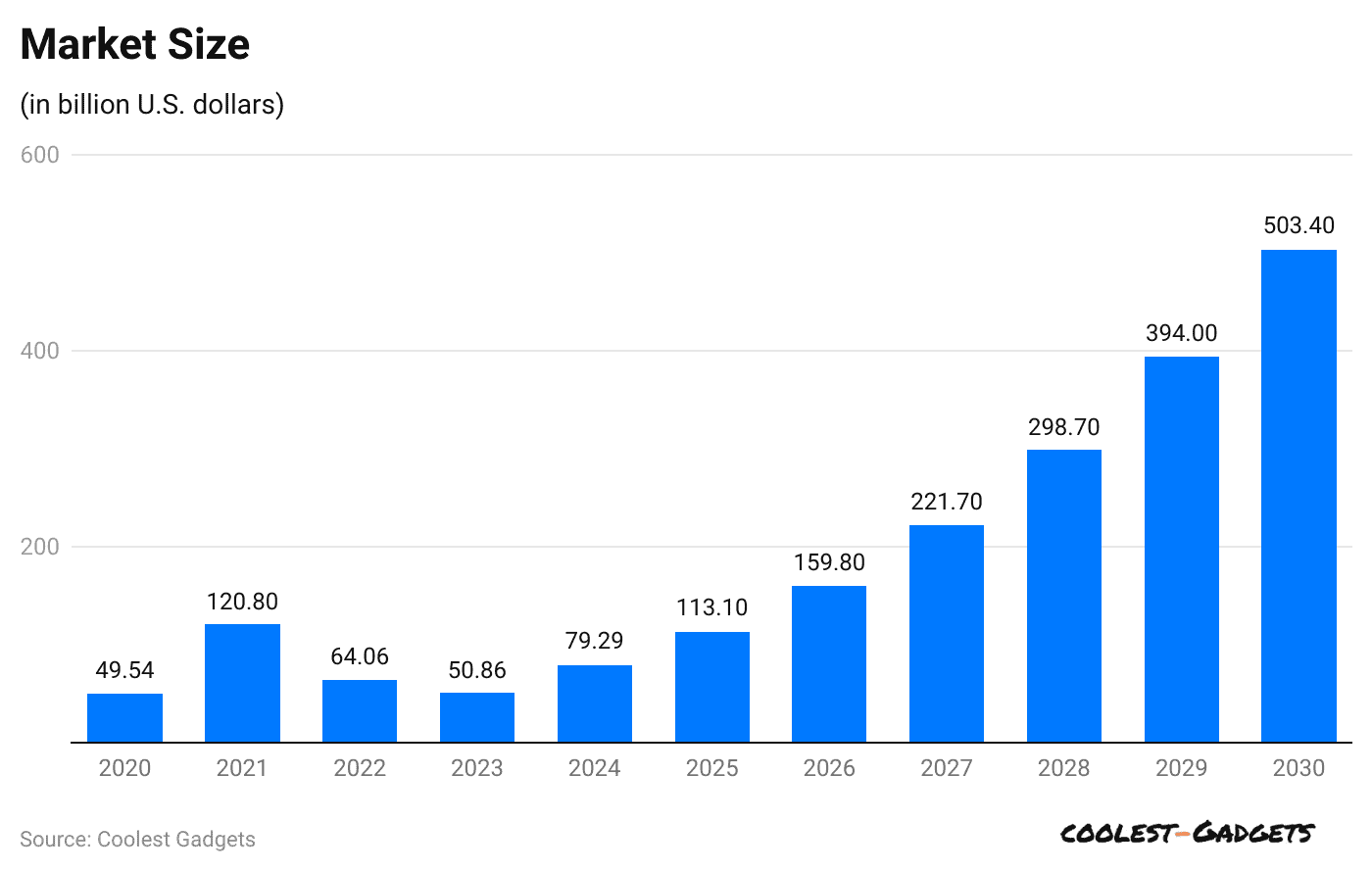 (Reference: statista.com)
(Reference: statista.com)
- Machine Learning Statistics state that the global Machine Learning market will reach USD 79.29 billion in size by 2024, an increase from USD 50.86 billion in 2023.
- The machine learning market will grow at an annual growth rate (CAGR) of 36.08% between 2024 and 2030, reaching an estimated value of USD 503.40 billion by 2030.
- Experts predict its value will reach USD 113.10 billion in 2025.
- By 2026, it may increase to USD 159.80 billion, followed by USD 221.70 billion in 2027.
- In 2028, the market size could rise to USD 298.70 billion, and by 2029, it is estimated to reach USD 394 billion.
The table below shows the Machine Learning market size change:
| Year | Growth Rate |
| 2023 |
-20.61% |
|
2024 |
55.92% |
| 2025 |
42.65% |
|
2026 |
41.27% |
| 2027 |
38.73% |
|
2028 |
34.74% |
| 2029 |
31.91% |
|
2030 |
27.76% |
Machine Learning Revenue Statistics by Country
- The Machine Learning market has grown to USD 21.14 billion in 2024.
- It is projected to increase at a growth rate of 36.07% from 2024 to 2030, resulting in USD 134.20 billion by 2030.
As per Machine Learning Statistics, the other top four countries’ market analyses in 2024 are stated in the table below:
| Country | Market Size (USD) | CAGR (from 2024 to 2030) |
| China | 15.15 billion |
36.07% |
|
Japan |
3.52 billion | 36.06% |
| Germany | 3.39 billion |
36.08% |
|
India |
2.81 billion |
36.11% |
- The market value of machine learning in different countries is reported as follows: The United Kingdom at USD 2.56 billion, France at USD 2.31 billion, Canada at USD 1.78 billion, Australia at USD 1.41 billion, Italy at USD 1.67 billion, and South Korea at USD 1.39 billion.
By Region
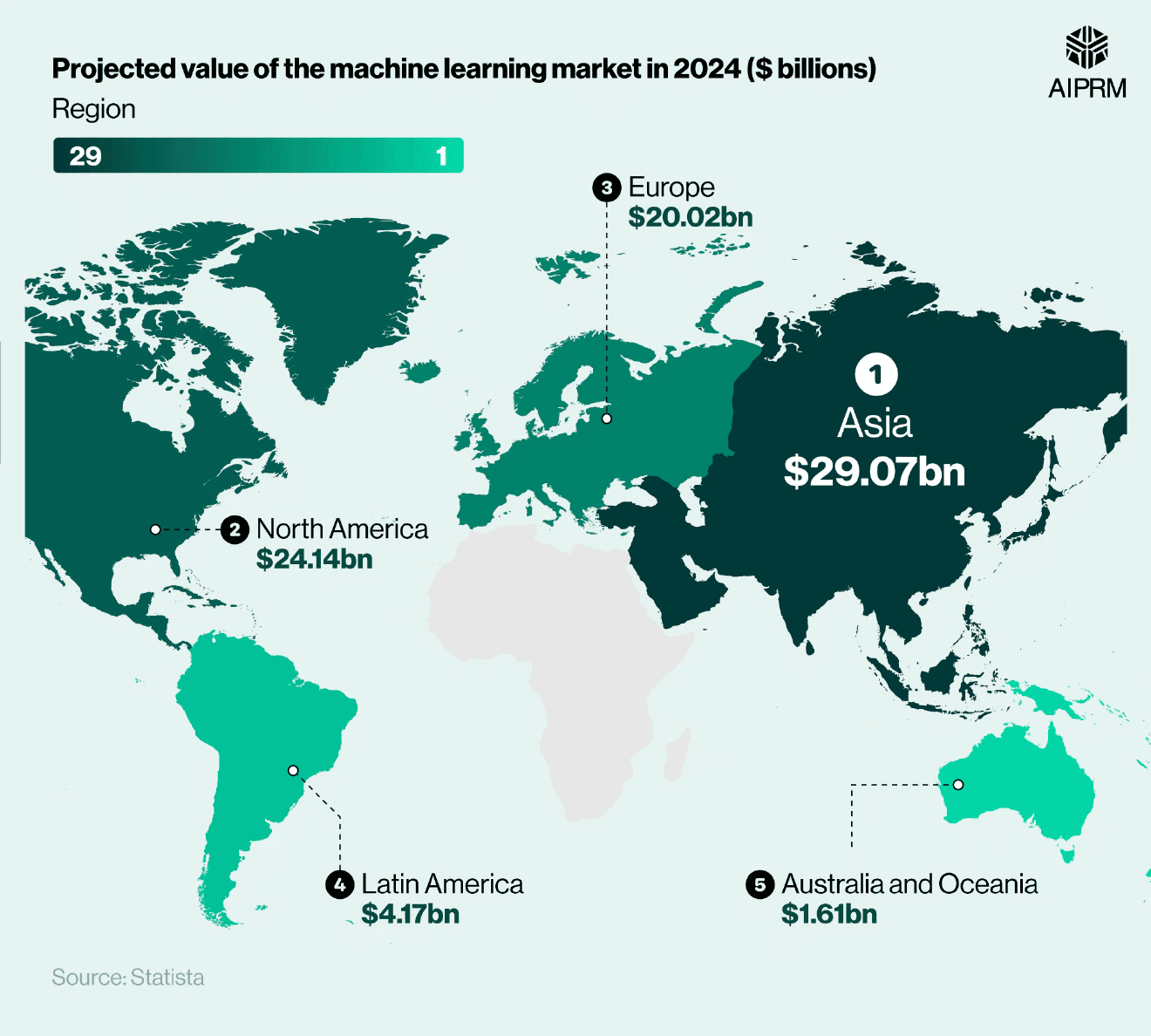 (Source: aiprm.com)
(Source: aiprm.com)
- Machine Learning Statistics in 2024 show that the continent’s machine learning industry will reach more than 29 billion, 20% higher than others.
| Region | Revenue (USD) | CAGR (2024 to 2029) |
| Asia | 29.07 billion |
36.08% |
|
Americas |
27.08 billion | 36.07% |
| Europe | 20.03 billion |
36.08% |
|
Africa |
1.49 billion | 36.10% |
| Australia & Oceania | 1.61 billion |
36.14% |
|
Caribbean |
94.54 million |
36.08% |
Machine Learning Statistics by Industry
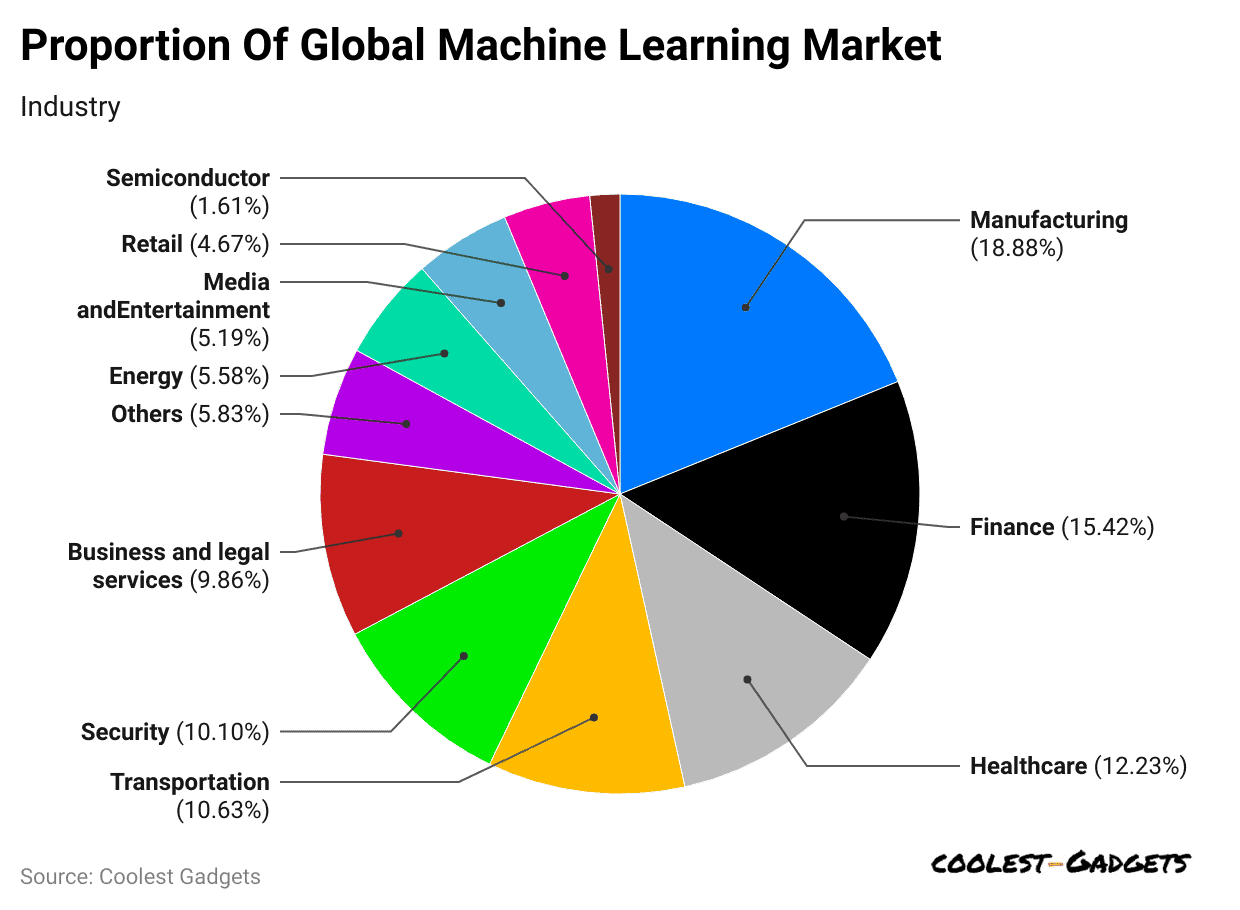 (Reference: aiprm.com)
(Reference: aiprm.com)
- The manufacturing industry uses machine learning the most, with 18.88% of the market. The finance sector follows, with a 15.42% share.
- Other industries also use machine learning, including healthcare (12.23%), transportation (10.63%), and security (10.10%).
- Business and legal services account for 9.86%, while the energy sector holds 5.58%. Media and entertainment use 5.19%, and retail takes up 4.67%.
- The semiconductor industry has the smallest share at 1.6%. All other industries together make up 5.83%.
- Machine learning is spreading across many fields, helping businesses work smarter and more efficiently.
By Company’s Usage
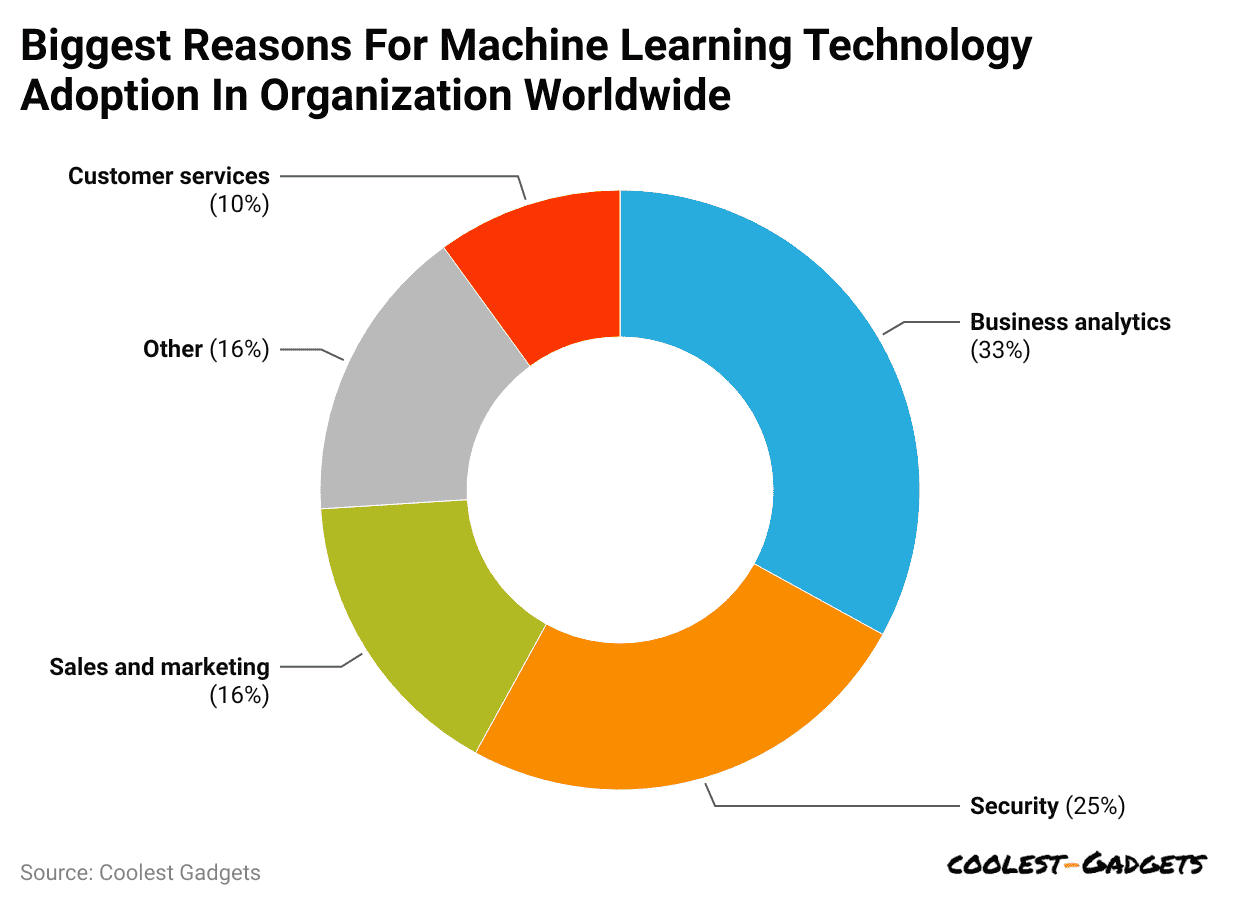 (Reference: founderjar.com)
(Reference: founderjar.com)
- Machine Learning Statistics In 2024, around 33% of companies preferred machine learning due to effective business analytics.
- Moreover, one in four IT leaders (25%) think machine learning can reduce security risks in their companies.
- On the other hand, usage shares are followed by sales and marketing (16%), customer service (10%) and others (16%).
Machine Learning Investment Statistics by Platforms
- Machine Learning Statistics also mentioned that OpenAI, the creator of ChatGPT, is the largest machine learning platform, receiving around USD 11.3 billion in funding by 2024.
- ScaleAI received USD 602.6 million, 45% more than others, making it the second-largest globally funded company.
- Adept and Cohere AI each received over USD 400 million in investments, with Adept receiving USD 415 million and Cohere AI following closely behind with USD 414.9 million.
Other platform’s investment statistics in the Machine Learning sector are detailed below in the table:
| Platforms | ML Investment (USD ) |
| Any scale |
259 million |
|
Inflection AI |
225 million |
| Weights and Biases |
205 million |
|
Hugging Face |
160.2 million |
| OctoML |
131.9 million |
|
A121Labs |
118.5 million |
Machine Learning Usage Statistics
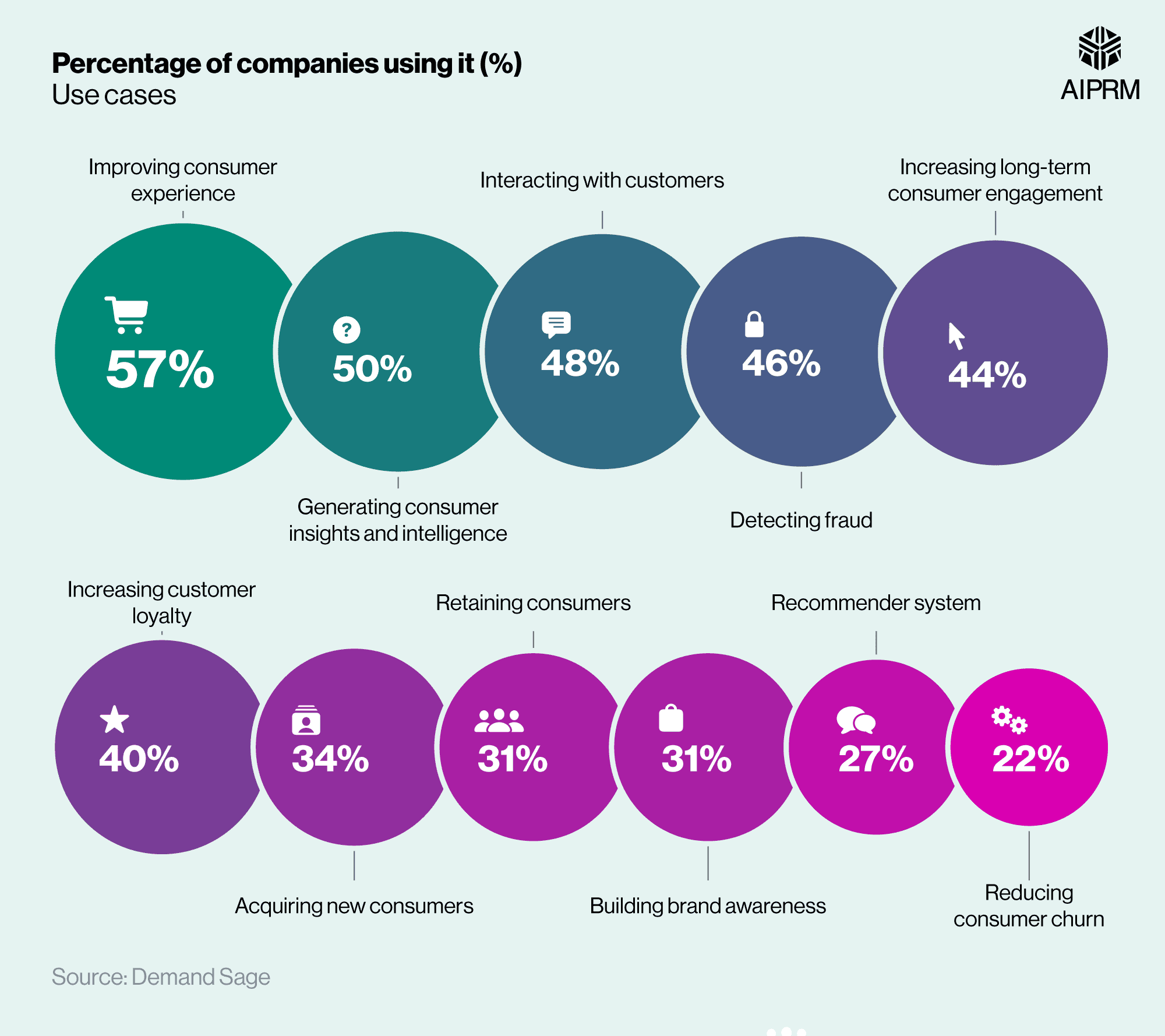 (Source: aiprm.com)
(Source: aiprm.com)
- A recent survey shows that 57% of businesses use machine learning to improve customer experience.
- This is the top reason, beating others like generating consumer insights (50%), which was the only other reason chosen by half the respondents.
- Based on Machine Learning Statistics also show that about 48% of businesses used machine learning for customer interactions, and slightly more than 46% used it for fraud detection.
- In 2024, around 44% of businesses focused on long-term engagement, and 40% prioritised boosting customer loyalty.
- Besides, only 22% of businesses used machine learning to cut customer churn and 27% for recommendations.
Machine Learning Companies Adoption Statistics
- As of 2024, one in three businesses (33%) say automating IT processes is their main reason for adopting AI, especially using machine learning.
- Detecting security threats was mentioned by 26% of businesses, while 25% of businesses mentioned automation and AI governance.
- During the same period, other companies’ machine learning adoption shares were in business analytics and intelligence, which are used in 24% of cases.
- Automating document processing, understanding, and flow also happens 24% of the time.
- Customer and employee self-service automation is used in 23% of situations.
- Business process automation is applied in 22% of cases.
- Digital labor solutions are used 22% of the time.
- Fraud detection systems are used in 22% of cases.
- Search and knowledge discovery is applied in 21% of situations.
- HR and talent hiring automation is used in 19% of cases.
- Financial planning and analysis account for 18%.
- Supply chain intelligence is used in 18% of cases.
Time Required To Deploy A Single Machine Learning Model
- Machine Learning Statistics in 2024 further show that 14% of organizations deployed a single machine learning model in just 0 to 7 days.
- 18% of people need to be made aware of how long it takes to implement machine learning.
| ML Deploying Time | Business Share |
| 8 to 30 days | 28% |
| 1 to 3 months | 22% |
| 3 months to 1 year | 13% |
| More than a year | 5% |
Machine Learning Usage Statistics
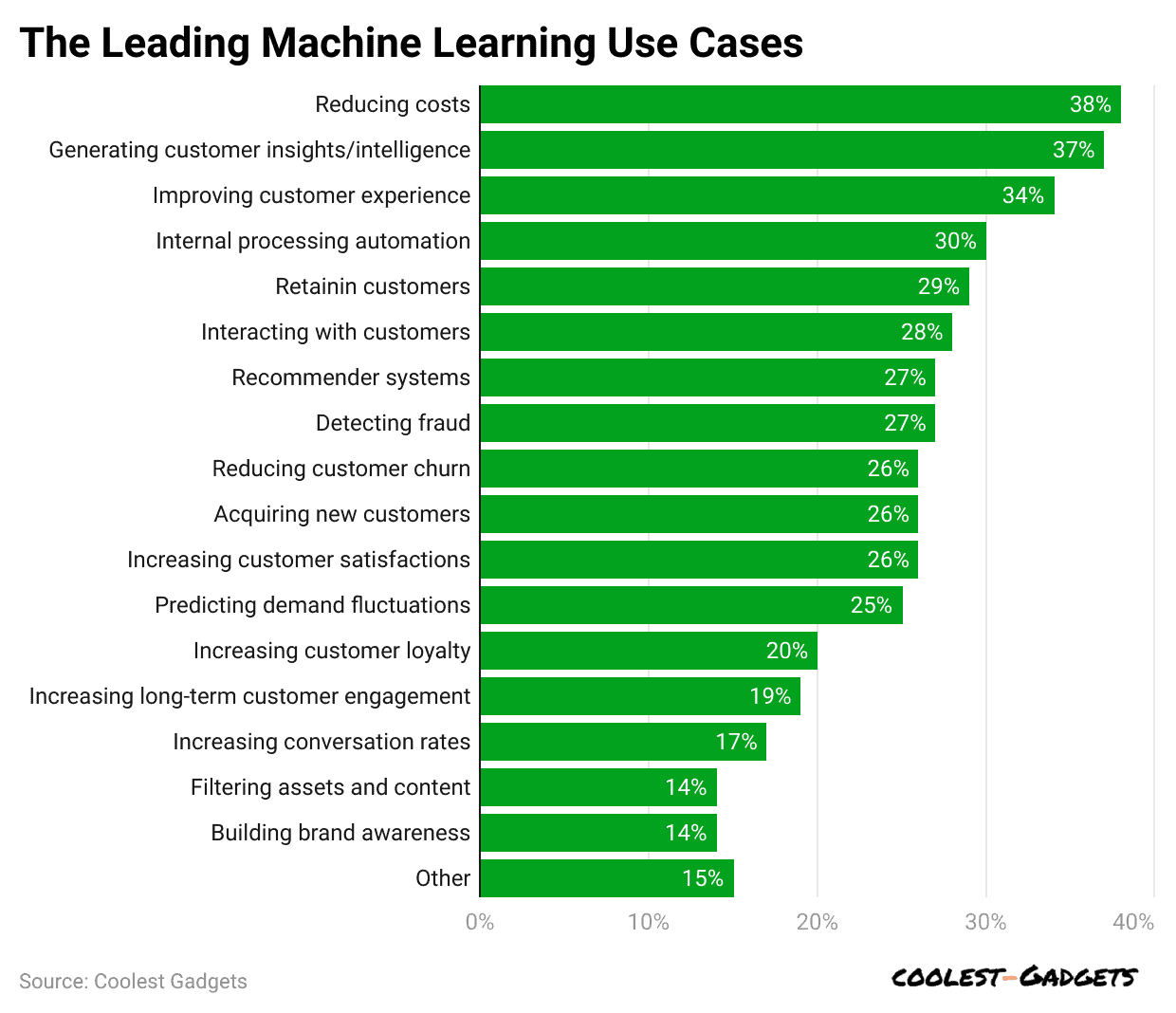 (Reference: founderjar.com)
(Reference: founderjar.com)
- Machine Learning Statistics also show that companies use machine learning mainly to save money and reduce costs, which accounts for 38% of the market in 2024.
- Other top reasons are generating customer insights/intelligence (37%), improving customer experience (34%), internal processing automation (30%), and retaining customers (29%).
- The least three reasons are increasing conversion rates (17%), filtering assets and content (14%) and building brand awareness (14%).
Machine Learning Statistics in Marketing
- As of 2024, almost 87% of companies using ML say they use it for sales forecasting in email marketing.
- AI is seen as the most important part of data strategies by 61% of marketers.
- Around 56.5% of marketers use AI and ML to personalize content and improve customer experiences.
- 16% said machine learning could enhance their sales and marketing efforts.
- ML helps predict customer churn, score leads accurately and build dynamic pricing models.
In Business
- As per Machine Learning Statistics, using machine learning algorithms helps businesses boost productivity by 54%.
- 45% of customers now prefer using chatbots for their customer service questions.
- About 15% of manufacturers are ready to adopt ML for widespread production.
- LinkedIn lists over 44,000 US jobs and 98,000 global jobs needing machine learning skills.
- Around 75% of businesses using AI and ML saw a 10% rise in customer satisfaction.
AI/ML Impact on Business Supply Chains Statistics by Region
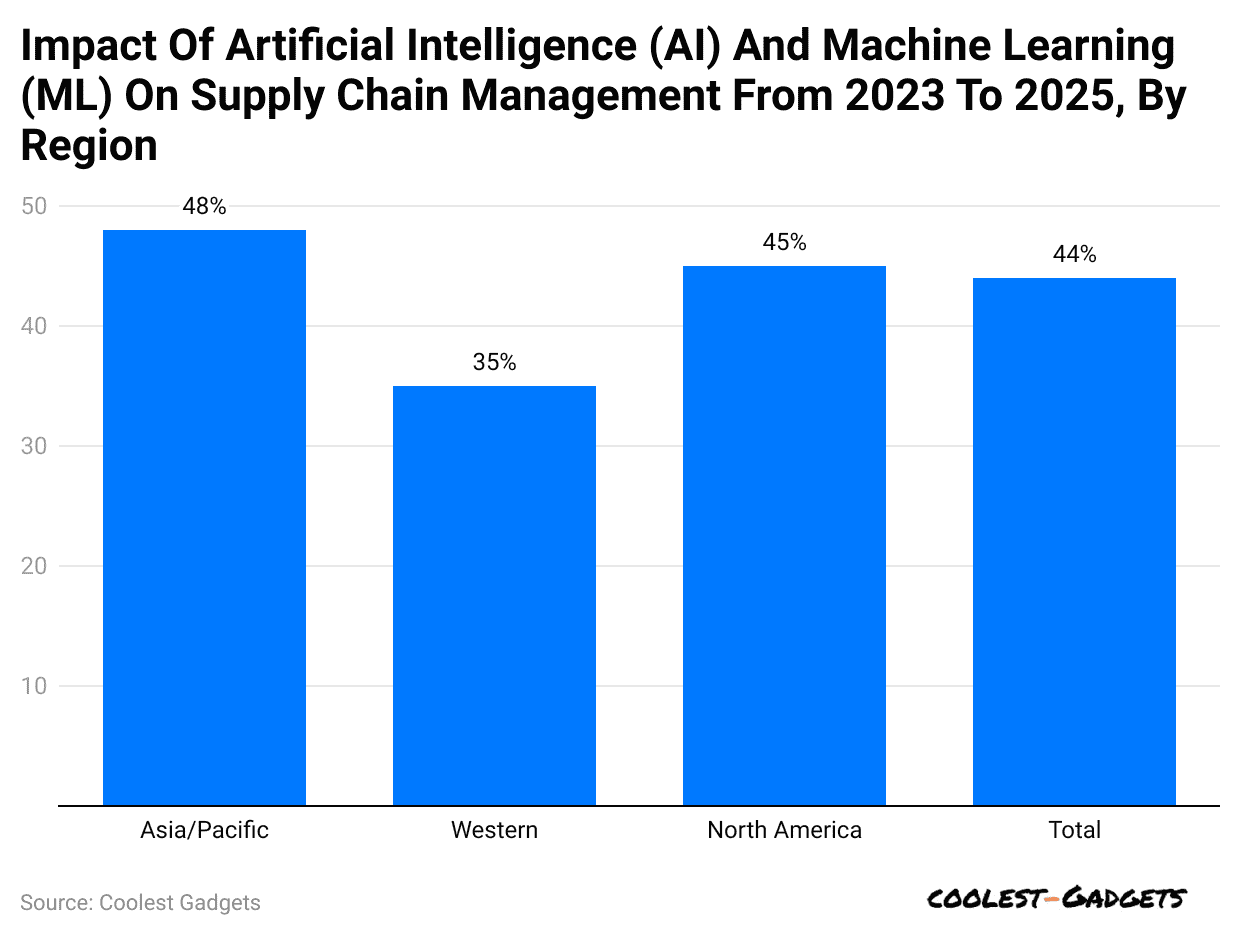 (Reference: statista.com)
(Reference: statista.com)
- The Asia Pacific region will see the most change in supply chains using AI and ML from 2023 to 2025, accounting for 48% of the total share.
- Furthermore, other region’s shares are stated as North America (45%), Western (35%), and Total (44%).
Impact of AI and ML Use on Retail Performance Statistics
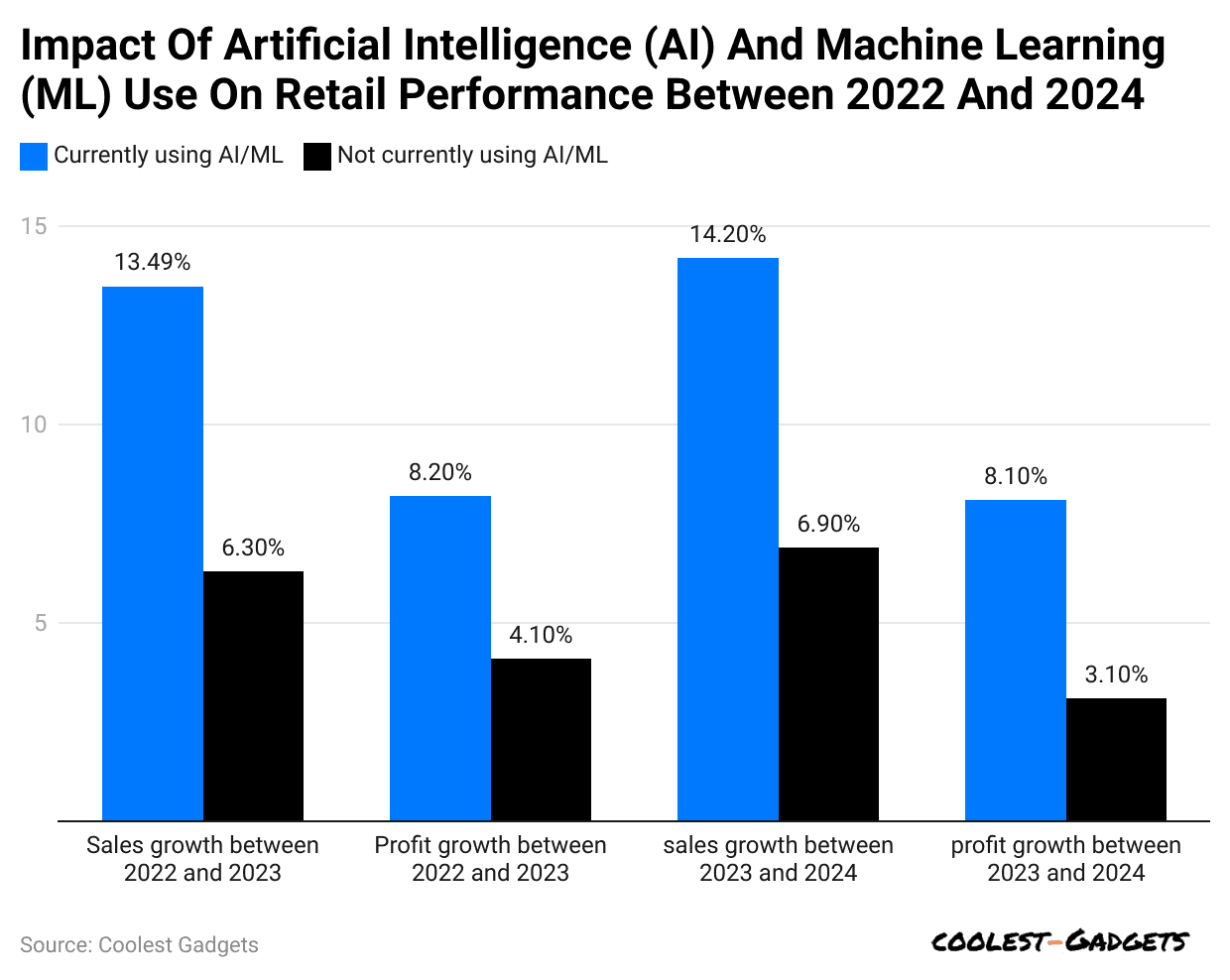 (Reference: statista.com)
(Reference: statista.com)
- The profit growth between 2023 and 2024 accounted for 8.1% of those who are currently using AI/ML and 3.1% (not currently using AI/ML).
- Similarly, sales growth in the same duration is 14.2% (currently using AI/ML) and 6.9% (not currently using AI/ML).
Demand Influencing Factors of Machine Learning
- In May 2024, OpenAI launched GPT-4, a powerful model that can work with text, images, and audio. This has helped machine learning grow in many industries.
- By 2024, nearly 48% of businesses worldwide had started using machine learning to improve their work and make better decisions.
- Databricks introduced DBRX, an open-source large language model, in March 2024.
- Google DeepMind announced plans to release Gemini 2.0 Flash in December 2024.
- The company aims to enhance AI capabilities in autonomous agents and further drive ML demand.
- 57% of companies utilize machine learning to improve customer experience, highlighting its role in enhancing client interactions.
Future Aspects of Machine Learning Statistics
- By the end of 2030, ML applications in healthcare, such as drug discovery, diagnostics, and personalized treatment, are expected to reach USD 20 billion.
- In the same duration, more than 70% of organizations globally are expected to leverage machine learning in their operations, with industries like retail, finance, and manufacturing leading the charge.
- Generative AI models are expected to generate 10% of all data globally by 2025, up from less than 1% in 2021.
- The global edge AI market, valued at USD 1.3 billion in 2023, is projected to grow to USD 8 billion by 2028.
- The autonomous vehicle market, heavily reliant on ML, is expected to reach USD 733.86 billion by 2030,
- NLP, a cornerstone of ML, is projected to grow from USD 29.71 billion in 2024 to USD 158.04 billion by 2032, revolutionizing customer service, language translation, and sentiment analysis.
- By 2025, at least 60% of organizations implementing AI will incorporate explainable AI (XAI) to enhance transparency and trust.
Conclusion
Machine learning is transforming industries worldwide, making tasks faster, smarter, and more efficient. As it grows, businesses, healthcare, education, and manufacturing continue to see its benefits in improving processes and solving complex problems.
However, responsible use and addressing ethical concerns are crucial as this technology advances. With continuous innovation, machine learning promises a future filled with opportunities for better decision-making, enhanced productivity, and creative solutions to challenges. Its potential is vast, shaping the world in remarkable ways.
Sources
FAQ.
Machine learning works by teaching computers to learn from data, identify patterns, and make predictions without explicit programming.
Machine learning is used in fraud detection, self-driving cars, medical diagnosis, voice assistants, and personal recommendations.
To learn machine learning, you need to know the basics of math, programming skills, data handling, problem-solving, and algorithms.
Artificial Intelligence (AI) is the broader concept of machines simulating human intelligence, while Machine Learning (ML) focuses on learning from data.
Machine learning powers everyday tools like voice assistants, online shopping recommendations, facial recognition, and spam email filters.

Saisuman is a talented content writer with a keen interest in mobile tech, new gadgets, law, and science. She writes articles for websites and newsletters, conducting thorough research for medical professionals. Fluent in five languages, her love for reading and languages led her to a writing career. With a Master’s in Business Administration focusing on Human Resources, Saisuman has worked in HR and with a French international company. In her free time, she enjoys traveling and singing classical songs. At Coolest Gadgets, Saisuman reviews gadgets and analyzes their statistics, making complex information easy for readers to understand.




